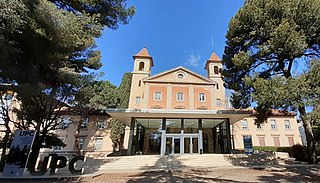
A supercomputer is a computer with a high level of performance as compared to a general-purpose computer. The performance of a supercomputer is commonly measured in floating-point operations per second (FLOPS) instead of million instructions per second (MIPS). Since 2017, there are supercomputers which can perform over 1017 FLOPS (a hundred quadrillion FLOPS, 100 petaFLOPS or 100 PFLOPS).
Grid computing is the use of widely distributed computer resources to reach a common goal. A computing grid can be thought of as a distributed system with non-interactive workloads that involve many files. Grid computing is distinguished from conventional high-performance computing systems such as cluster computing in that grid computers have each node set to perform a different task/application. Grid computers also tend to be more heterogeneous and geographically dispersed than cluster computers. Although a single grid can be dedicated to a particular application, commonly a grid is used for a variety of purposes. Grids are often constructed with general-purpose grid middleware software libraries. Grid sizes can be quite large.

MareNostrum is the main supercomputer in the Barcelona Supercomputing Center. It is the most powerful supercomputer in Spain, one of thirteen supercomputers in the Spanish Supercomputing Network and one of the seven supercomputers of the European infrastructure PRACE.

The Barcelona Supercomputing Center is a public research center located in Barcelona, Catalonia, Spain. It hosts MareNostrum, a 13.7 Petaflops, Intel Xeon Platinum-based supercomputer, which also includes clusters of emerging technologies. In June 2017, it ranked 13th in the world. As of November 2021, it dropped to 74th.

The NASA Advanced Supercomputing (NAS) Division is located at NASA Ames Research Center, Moffett Field in the heart of Silicon Valley in Mountain View, California. It has been the major supercomputing and modeling and simulation resource for NASA missions in aerodynamics, space exploration, studies in weather patterns and ocean currents, and space shuttle and aircraft design and development for almost forty years.

TeraGrid was an e-Science grid computing infrastructure combining resources at eleven partner sites. The project started in 2001 and operated from 2004 through 2011.
The Spanish National Bioinformatics Institute is an academic service institution tasked with the coordination, integration and development of bioinformatics resources in Spain. Created in 2003, the INB is—since 2015—the main node through which the Carlos III Health Institute is connected to ELIXIR, a European-wide infrastructure of life science data, coordinating the other Spanish institutions partaking in the initiative such as the Spanish National Cancer Research Centre (CNIO), the Centre for Genomic Regulation (CRG), the Universitat Pompeu Fabra, the Institute for Research in Biomedicine (IRB) and the Barcelona's National Supercomputing Center.
The Pittsburgh Supercomputing Center (PSC) is a high performance computing and networking center founded in 1986 and one of the original five NSF Supercomputing Centers. PSC is a joint effort of Carnegie Mellon University and the University of Pittsburgh in Pittsburgh, Pennsylvania, United States.
The Texas Advanced Computing Center (TACC) at the University of Texas at Austin, United States, is an advanced computing research center that provides comprehensive advanced computing resources and support services to researchers in Texas and across the USA. The mission of TACC is to enable discoveries that advance science and society through the application of advanced computing technologies. Specializing in high performance computing, scientific visualization, data analysis & storage systems, software, research & development and portal interfaces, TACC deploys and operates advanced computational infrastructure to enable computational research activities of faculty, staff, and students of UT Austin. TACC also provides consulting, technical documentation, and training to support researchers who use these resources. TACC staff members conduct research and development in applications and algorithms, computing systems design/architecture, and programming tools and environments.
DGSCA, a.k.a. Computo Academico UNAM, previously known as PUC. It is the leading organization within the UNAM for computer technologies systems and held the distinction for being the first institution in México to install and operate a Cray Y-MP super computer, in early 1990.
The Institute for Biocomputation and Physics of Complex Systems (BIFI) is a research center of the University of Zaragoza devoted to the study of complex systems from a multidisciplinary perspective. In this Institution, biochemists, physicists, mathematicians, computer scientists and researchers from other fields study complex systems, as well as different phenomena and processes related to them. The ultimate goal is to unravel various aspects of complexity, promote basic science and assess the impact of applied research and possible benefits for society.

Magerit is the name of the one of the most powerful supercomputers in Spain. It also reached the second best Spanish position in the TOP500 list of supercomputers. This computer is installed in CeSViMa, a research center of the Technical University of Madrid.

The Supercomputing and Visualization Center of Madrid (CeSViMa) also called Madrid Supercomputing and Visualization Center depends on the computer science faculty of the Technical University of Madrid. This center houses Magerit, one of the most powerful supercomputers in Spain. This center is a member of the Spanish Supercomputing Network, the Spanish e-Science Network and the Madrid Laboratories and Infraestructures Network.

Finisterrae was the 100th supercomputer in Top500 ranking in November 2007. Running at 12.97 teraFLOPS, it would rank at position 258 on the list as of June 2008. It is also the third most powerful supercomputer in Spain. It is located in Galicia.

The Distributed European Infrastructure for Supercomputing Applications (DEISA) was a European Union supercomputer project. A consortium of eleven national supercomputing centres from seven European countries promoted pan-European research on European high-performance computing systems. By extending the European collaborative environment in the area of supercomputing, DEISA followed suggestions of the European Strategy Forum on Research Infrastructures.

Jaguar or OLCF-2 was a petascale supercomputer built by Cray at Oak Ridge National Laboratory (ORNL) in Oak Ridge, Tennessee. The massively parallel Jaguar had a peak performance of just over 1,750 teraFLOPS. It had 224,256 x86-based AMD Opteron processor cores, and operated with a version of Linux called the Cray Linux Environment. Jaguar was a Cray XT5 system, a development from the Cray XT4 supercomputer.

Mateo Valero Cortés is a Spanish computer architect. His research encompasses different concepts within the field of computer architecture, a discipline in which he has published more than 700 papers in journals, conference proceedings and books. Valero has received numerous awards, including the Eckert–Mauchly Award in 2007, for "extraordinary leadership in building a world class computer architecture research center, for seminal contributions in the areas of vector computing and multithreading, and for pioneering basic new approaches to instruction-level parallelism." He is the director of the Barcelona Supercomputing Center, which hosts the MareNostrum supercomputer.

Several centers for supercomputing exist across Europe, and distributed access to them is coordinated by European initiatives to facilitate high-performance computing. One such initiative, the HPC Europa project, fits within the Distributed European Infrastructure for Supercomputing Applications (DEISA), which was formed in 2002 as a consortium of eleven supercomputing centers from seven European countries. Operating within the CORDIS framework, HPC Europa aims to provide access to supercomputers across Europe.
The HPC-Europa programmes are European Union (EU) funded research initiatives in the field of high-performance computing (HPC). The programmes concentrate on the development of a European Research Area, and in particular, improving the ability of European researchers to access the European supercomputing infrastructure provided by the programmes' partners. The programme is currently in its third iteration, known as "HPC-Europa3" or "HPCE3", and fully titled the "Transnational Access Programme for a Pan-European Network of HPC Research Infrastructures and Laboratories for scientific computing".

The European High-Performance Computing Joint Undertaking is a public-private partnership in High Performance Computing (HPC), enabling the pooling of European Union–level resources with the resources of participating EU Member States and participating associated states of the Horizon 2020 programme, as well as private stakeholders. The Joint Undertaking has the twin stated aims of developing a pan-European supercomputing infrastructure, and supporting research and innovation activities. Located in Luxembourg City, Luxembourg, the Joint Undertaking started operating in November 2018 and will remain operational until the end of 2026.














